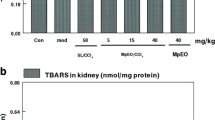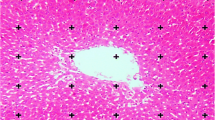Abstract
This study was performed to elucidate the effects of Undaria pinnatifida fucoidan extract (UPFE) in preventing CCl4-induced oxidative stress. UPFE (100 mg/kg) was intraperitoneally administered to rats for 14 days. On day 15, CCl4 dissolved in olive oil (50% CCl4) was injected 12 h before they were anesthetized and dissected. To measure UPFE-mediated antioxidation, we examined the levels of glutamate oxaloacetate transaminase (GOT), glutamate pyruvate transaminase (GPT), alkaline phosphatase (ALP), and lactate dehydrogenase (LDH) in serum, as well as malondialdehyde (MDA), superoxide dismutase (SOD), catalase (CAT), and glutathione peroxidase (GPx) in liver homogenates. CCl4 treatment markedly increased the levels of GOT, GPT, ALP, LDH, and MDA and significantly decreased levels of SOD, CAT, and GPx. UPFE pretreatment decreased levels of GOT, GPT, ALP, LDH, and MDA, by 62.8, 68.5, 41.9, 72.7, and 122%, respectively and increased those of SOD, CAT, and GPx by 111.1, 15.9, and 52.6%, respectively. These results showed that UPFE has antioxidant effects against CCl4-induced oxidative stress.
Similar content being viewed by others
References
Scandalios, J. G (1997) Oxidative Stress and the Molecular Biology of Antioxidant Defenses. pp. 890. Cold Spring Harbor Laboratory Press, Cold Spring Harbor, NY, USA.
Freeman, B. A. (1984) Biological sites and mechanism of free radical production. pp. 43–52. In: D. Armstrong, R. Sohal, R. G. Culter, and T. Slater (eds.). Free Radicals in Molecular Biology, Aging, and Disease. Raven Press, New York, NY, USA.
Miquel, J. (1989) CRC Handbook of Free Radicals and Antioxidants in Biomedicine. Vol. I, pp. 17–25. CRC Press, Inc., Boca Raton, FL, USA.
Hagihara, M., I. Nishigaki, M. Maseki, and K. Yagi (1984) Age-dependent changes in lipid peroxide levels in the lipoprotein fractions of human serum. J. Gerontol. 39: 269–272.
Kurata, M., M. Suzuki, and N. S. Agar (1993) Antioxidant systems and erythrocyte life-span in mammals. Comp. Biochem. Physiol. B 106: 477–487.
Halliwell, B., J. M. Gutteridge, and C. E. Cross (1992) Free radicals, antioxidants, and human disease: where are we now? J Lab. Clin. Med. 119: 598–620.
Puglia, C. D. and S. R. Powell (1984) Inhibition of cellular antioxidants: a possible mechanism of toxic cell injury. Environ. Health Perspect. 57: 307–311.
Salminen, A., H. Kainulainen, A. U. Arstila, and V. Vihko (1984) Vitamin E deficiency and the susceptibility to lipid peroxidation of mouse cardiac and skeletal muscles. Acta Physiol. Scand. 122: 565–570.
Seo, Y., S. H. Kang, H. J. Lee, Y. A. Kim, H. J. Youn, B. J. Lee, and H. Chung (2006) In vitro screening of seaweed extract on the proliferation of mouse spleen and thymus cell. Biotechnol. Bioprocess Eng. 11: 160–163.
Lee, H. J., Y. A. Kim, J. W. Ahn, H. J. Na, H. M. Kim, and Y. Seo (2006) Screening of Korean marine plants for their inhibitory effect on histamine release from RPMC in vitro. Biotechnol. Bioprocess Eng. 11: 80–83.
Berteau, O. and B. Mulloy (2003) Sulfated fucans, fresh perspectives: structures, functions, and biological properties of sulfated fucans and an overview of enzymes active toward this class of polysaccharide. Glycobiology 13: 29–40.
Daniel, R., L. Chevolot, M. Carrascal, B. Tissot, P. A. Mourao, and J. Abian (2007) Electrospray ionization mass spectrometry of oligosaccharides derived from fucoidan of Ascophyllum nodosum. Carbohydr. Res. 342: 826–834.
Tako, M., M. Uehara, Y. Kawashima, I. Chinen, and F. Hongo (1996) Isolation and identification of fucoidan from Okinawamozuku, Oyo Toshitsu Kagaku. J Appl. Glycosci. 43: 143–148.
Lowry, O. H., N. J. Rosebrough, A. L. Farr, and R. J. Randall (1951) Protein measurement with the folin phenol reagent. J Biol. Chem. 193: 265–275.
Ha, B. J., S. H. Lee, H. J. Kim, and J. Y. Lee (2006) The role of Salicornia herbacea in ovariectomy-induced oxidative stress. Biol. Pharm. Bull. 29: 1305–1309.
Beauchamp, C. and I. Fridovich (1971) Superoxide dismutase: improved assays and an assay applicable to acrylamide gels. Anal. Biochem. 44: 276–287.
Aebi, H. (1984) Catalase in vitro. Methods Enzymol. 105: 121–126.
Lawrence, R. A. and R. F. Burk (1976) Glutathione per-oxidase activity in selenium-deficient rat liver. Biochem. Biophys. Res. Commun. 71: 952–958.
Pari, L. and N. A. Kumar (2002) Hepatoprotective activity of Moringa oleifera on antitubercular drug-induced liver damage in rats. J Med. Food 5: 171–177.
Pari, L. and P. Murugan (2004) Protective role of tetra-hydrocurcumin gainst erythromycin estolate-induced hepatotoxicity. Pharmacol. Res. 49: 481–486.
Sallie, R., J. M. Tredger, and R. Williams (1991) Drugs and the liver. Biopharm. Drug Dispos. 12: 251–259.
Lima, C. F., F. Carvalho, E. Fernandes, M. L. Bastos, P. C. Santos-Gomes, M. Fernandes-Ferreira, and C. Pereira-Wilson (2004) Evaluation of toxic/protective effects of the essential oil of Salvia officinalis on freshly isolated rat hepatocytes. Toxicol. In Vitro 18: 457–465.
Kim, I. H., D. G. Lee, S. H. Lee, J. M. Ha, B. J. Ha, S. K. Kim, and J. H. Lee (2007) Antibacterial activity of Ulva lactuca against methicillin-resistant Staphylococcus aureus (MRSA). Biotechnol. Bioprocess Eng. 12: 579–582.
Lee, H. J. and Y. Seo (2006) Antioxidant properties of Erigeron annuus extract and its three phenolic constituents. Biotechnol. Bioprocess Eng. 11: 13–18.
Lee, J. Y., S. H. Lee, H. J. Kim, J. M. Ha, S. H. Lee, J. H. Lee, and B. J. Ha (2004) The preventive inhibition of chondroitin sulfate against the CCl4-induced oxidative stress of subcellular level. Arch. Pharm. Res. 27: 340–345.
Author information
Authors and Affiliations
Corresponding author
Rights and permissions
About this article
Cite this article
Kang, K.S., Kim, I.D., Kwon, R.H. et al. Undaria pinnatifida fucoidan extract protects against CCl4-induced oxidative stress. Biotechnol Bioproc E 13, 168–173 (2008). https://doi.org/10.1007/s12257-007-0101-1
Received:
Accepted:
Published:
Issue Date:
DOI: https://doi.org/10.1007/s12257-007-0101-1




